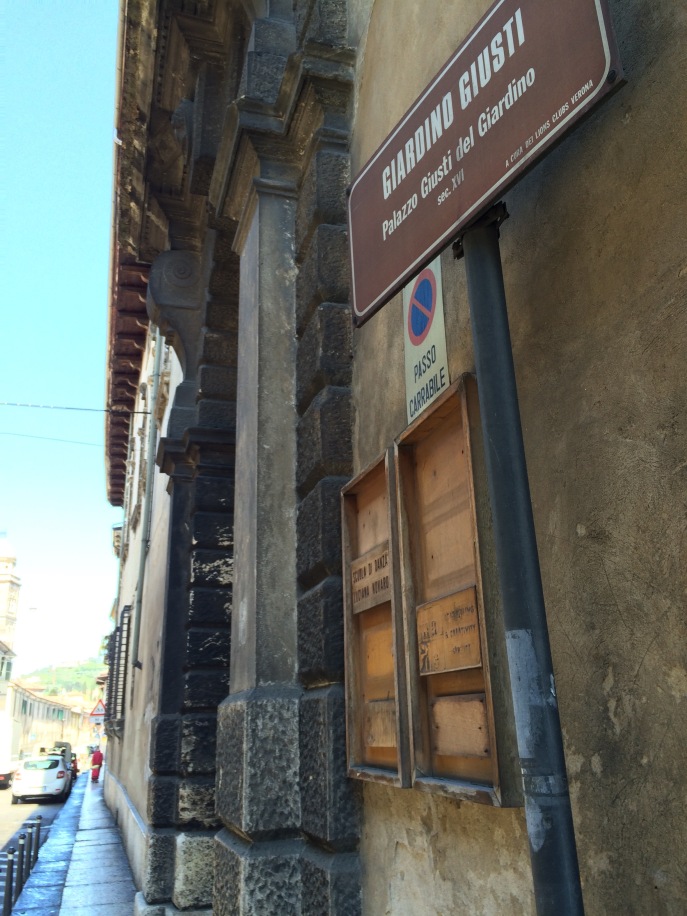After our photo storage debacle—and the loss of almost all of my images of the Giardini Botanici Hanbury—I was determined to go to another of Italy’s great gardens so as to provide at least one great series of photos on this blog. Little did I know that I would soon be seeing one of Italy’s greatest gardens, and one of the most beautiful places I’ve ever seen in my life. 
By this point in our trip I was not feeling well. My chronic health issues were causing a great deal of distress but I was determined to drive there. (I should add here that my husband doesn’t drive in Italy and cannot drive a manual shift car.) Luckily, we still had a FIAT Abarth, so getting to where we needed to go was not an issue.

Note the heavy wood ceiling. Veneto is full of thick heavy wood. This is very different from many of the other regions of Italy.
The garden is considered one of the finest examples of an Italian garden. Created in the sixteenth-century, this is an Italian Renaissance garden. There are many styles of gardens in Europe—and I’m still far from an expert on this subject—but seeing this garden really inspired me to learn more. (I think my next trip will most certainly be a more in-depth exploration of great gardens.)
Created in the sixteenth-century, this is an Italian Renaissance garden. There are many styles of gardens in Europe—and I’m still far from an expert on this subject—but seeing this garden really inspired me to learn more. (I think my next trip will most certainly be a more in-depth exploration of great gardens.)
As a life-long tree hugger, I had to hug this “trunk of an old existing cypress in the garden in the fifteenth century.” It’s not quite a Californian redwood, but I was impressed and had nothing more than thoughts of the many people who’d been here before me.
The traditional plant palette of an Italian garden is quite limited and involves a lot of mass plantings of evergreen plants for an astonishing effect that simply must be seen in person.

A Parthenocissus vine covers the wall and makes a fine green drape.
Like any great garden, it transports you to another place, another level of existence, and it leaves you in awe. It also left me wanting to never leave. 
For me, what started as a spiritual feeling left me that day with a sense of splendor and ecstatic sensation.

If you look closely at the top of the hill you’ll see Il mascherone or a gargoyle. It is a man’s face and was originally designed to have flames coming out of his mouth. The entryway you see is an entrance to a grotto but sadly there is no more water inside. (You will see a photo of it in an upcoming post.) By the way, all the classical elements are represented in the garden.
As I told my husband, any great garden should leave you with a feeling of hysteric pleasure—for some this might be a restrained thing, but for me, a girl raised on the Left Coast of the United States, I just wanted to party. (I will leave you with that without going into further detail.) 
The garden is known for its terraces and its labyrinth. A traditional Italian garden is very green. This is in such sharp opposition to the usual colors of towns, and you’ll see this in upcoming images.  It truly is a feast for your eyes and why not send your husband off into the labyrinth? I was fairly certain that Minos was still in Greece and that John would not encounter a minotaur here although I thought about it. That’s what these gardens were intended for, and so I let my mind be transported back to the ancient classical stories of Italy and Greece. (I should also add that all references to Catholicism have been removed. I will get to that in later posts as well.)
It truly is a feast for your eyes and why not send your husband off into the labyrinth? I was fairly certain that Minos was still in Greece and that John would not encounter a minotaur here although I thought about it. That’s what these gardens were intended for, and so I let my mind be transported back to the ancient classical stories of Italy and Greece. (I should also add that all references to Catholicism have been removed. I will get to that in later posts as well.) It should come as no great surprise to you that food is important in Italy and all great Italian gardens will have citrus. The lemon is known to have arrived in Italy during the time of classical Rome.
It should come as no great surprise to you that food is important in Italy and all great Italian gardens will have citrus. The lemon is known to have arrived in Italy during the time of classical Rome. In the next two posts we’ll walk to the top of the garden. This is a garden seen in layers, with so many beautifully designed angles. Everywhere you look, you see beauty.
In the next two posts we’ll walk to the top of the garden. This is a garden seen in layers, with so many beautifully designed angles. Everywhere you look, you see beauty.












